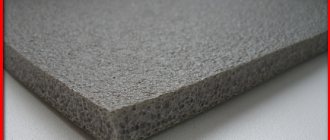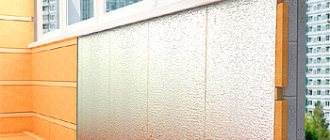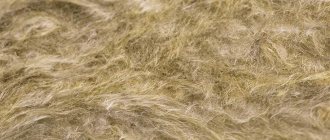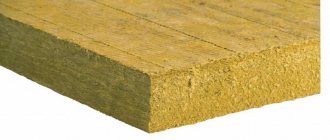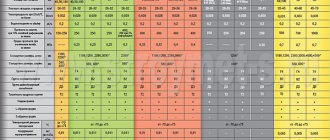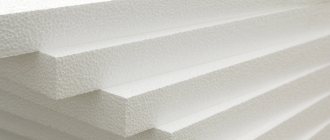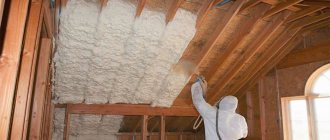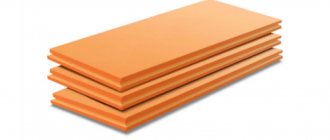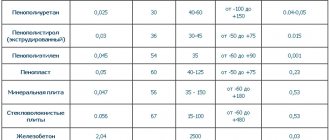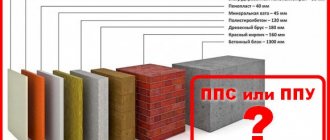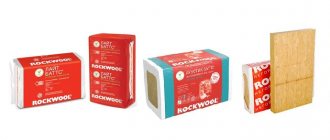Styrofoam
Polystyrene foam is a porous and lightweight insulation material. Made from polystyrene by foaming. It is considered one of the best (at low cost) in relation to other thermal insulation materials. It is produced in the form of slabs of different sizes, densities and thicknesses. It has good thermal insulation characteristics, as it consists of tightly connected sealed balls filled with air or gas.
Advantages of foamed polystyrene:
- low thermal conductivity coefficient - 0.035 W/m K;
- ecologically pure;
- does not allow damp air to pass through;
- can last for decades;
- not subject to rotting;
- windproof.
Foam is easy to install by one person, as it is light in weight. It is used both inside the living space - walls, ceiling, floor, and outside. They are used to decorate different surfaces: wood, brick, concrete and others.
It is not used as sound insulation, as it has weak sound insulating properties.
The most common materials for heat and sound insulation
Foamed polyethylene
One of the most modern, effective and inexpensive materials for thermal insulation.
It is made from a high-quality polyethylene compound, but has one feature - the presence of special air-filled pores. The characteristics of this material allow it to be used in different temperature ranges - from -40 to +90 degrees. Air humidity can be at its maximum. The versatility of foamed polyethylene allows it to be used for insulating window openings, cracks between wall slabs, when installing doors, etc. For the convenience of construction work, foamed polyethylene is produced in the form of rolls, tubes and cords. In addition to thermal insulation, it also copes well with the task of hydro- and sound insulation.
The main characteristics of polyethylene material: environmental friendliness, durability, versatility, elasticity, resilience, resistance to mechanical and chemical influences, low thermal conductivity and water absorption.
Extruded polystyrene foam
Externally, extruded polystyrene foam is similar to regular polystyrene foam, but has a higher density and thinner thickness. An extruder is used in its production. Thanks to this, extruded polystyrene foam has closed cells of the same size.
Due to its high density, extrusion is used in the construction of railways and highways, as well as runways. This material has excellent strength, so it can be used not only as thermal insulation, but also as an auxiliary or load-bearing structure.
Positive qualities of extruded polystyrene foam:
- does not absorb liquids;
- does not sit down;
- not afraid of chemicals;
- does not rot and is not overgrown with mold and fungi;
- service life - about 50 years;
- has one of the lowest thermal conductivity coefficients.
It is used for insulation of walls, ceilings, floors, foundations in private houses, apartments and industrial facilities. Just like polystyrene foam, it is used only as thermal insulation.
Video: How to install a soundproofing partition using Rockwool Acoustic material
Attention! It is important to remember that enduring constant noise is harmful to your health. They cause irritation, headaches and cause deterioration in mood.
And if noise constantly interferes, it turns life into a complete nightmare. Therefore, by spending money and time on sound insulation once, you will receive excellent dividends in peace and quiet. Buy proven sound insulation Rockwool Acoustic Butts at an attractive price! This material has been time-tested at thousands of facilities across the country.
Polyurethane foam
Consists of two components: polyul and isocyanate. By mixing these substances on special equipment, you can obtain polyurethane foam of different states - from elastic to hard. Polyurethane foam has one of the best thermal conductivity coefficients, so it is used for heat and sound insulation of residential buildings and other objects. The consistency is similar to foam.
Article on the topic: Where and how Euroblock sound insulation is used
It can be applied to any structure by spraying. In just a few seconds, a durable and seamless layer of thermal insulation material is obtained. It is important that all application technology rules are followed. Only qualified personnel should work with this thermal insulation using appropriate equipment.
Positive characteristics of polyurethane foam:
- operating temperature - from −150°С to +200°С;
- thermal conductivity coefficient 0.022-0.028 W/m K;
- sprayed onto any surface;
- a durable and monolithic layer is formed;
- has anti-corrosion properties;
- long service life;
- environmentally friendly;
- excellent soundproofing material;
- does not require additional transportation costs, since all components are brought by the service company.
Soundproofing walls with ecowool and glass wool
The technology for using ecowool and glass wool is so similar that we decided not to consider these two materials independently. Instead, we will give a general picture of the situation, ultimately making small additions for each of the two cases. The finishing methods are completely similar. The idea itself is borrowed from the design of frame houses. The process itself involves creating a sandwich assembly. This is what it looks like in frame houses:
Insulator sheets
- A sheathing is created along the wall for the purchased facing material. It can be made of wood or steel profile.
- Sheets of the selected insulation are placed under the sheathing. This is usually glass wool.
- The insulation layer is covered with a thin vapor barrier membrane, which is placed directly on the sheathing.
- Then the entire structure is lined.
In the case of vapor barrier work, we have some differences from this picture. A vapor barrier membrane is not a required component unless the wall faces the street. The purpose of this film is to reduce the rate of filtration of steam from the room. But in our case, this element can be useful for this. As glass wool is used, fine dust is separated from it over time. The chance that it penetrates into the room from under the cladding is quite small. A vapor barrier membrane further reduces this likelihood.
Basalt wool
During the production process, mineral wool is obtained from molten basalt rock processed using a special technology. Additives and binders are also added. Basalt slabs are used for insulation of residential premises and other buildings. They are very convenient for installation, as they are easy to cut with a knife. They can be given any desired shape and installed close to the structure of the house. Basalt slabs are often used as sound insulation on external or internal walls.
It is convenient to insulate inclined surfaces in attic buildings with mineral wool of the required thickness. Basalt wool is well suited as a fire protection device for parts of roofs and roofing in stove-heated houses and bathhouses.
Properties of basalt wool:
- low hygroscopicity;
- high sound insulation ability;
- easy to process;
- has low deformation;
- is a non-flammable material;
- has high thermal insulation qualities.
Properties of mineral wool
The material, in addition to soundproofing properties, has other characteristics:
- Vapor permeability. The property is to conduct condensate so that it does not linger and accumulate inside. Stone wool has the best performance. They are 0.35 mg/m2. x h x Pa.
- Density. Such indicators for stone wool range from 20-220 kg/m3. Depending on the density, the rigidity of the material changes. Wool with a density of 200 kg/m3 can withstand loads of up to 700 kg. The lower the density, the softer the wool, therefore, it is easier to work with it on shaped surfaces, in places with increased unevenness.
- Thermal conductivity. According to the standards, this value should correspond to the value of 0.45 W/m x K.
Mineral wool is a non-flammable material. When heated, no caustic substances are released. Withstands temperatures up to 700 degrees without any consequences.
Cork
An environmentally friendly wood material made from oak bark and having a porous structure. All cells are filled with inert gas. It has positive qualities in sound and heat insulation when used in residential premises. Not used outside.
Materials made from technical cork provide excellent sound insulation. It can be divided into three application groups:
- Agglomerate panels are made from crushed cork oak bark, followed by steam treatment and then pressed. Since the bark contains the adhesive substance suberin, unnatural additives are not required. Two types of panels are made: white - from bark taken from tree branches, and black - from stem bark.
- Natural cork - used for decorating rooms. The panels are additionally coated with wax, after which they will not be able to absorb moisture and odors.
- Cork granules are used for insulation of frame buildings.
Article on the topic: Review of modern materials for soundproofing walls in an apartment
Technical cork is produced in three forms: sheet, rolled, and in the form of mats.
Roll insulation is most often used as a backing for wallpaper. It comes with or without antibacterial and fireproof impregnation. It is produced in lengths of 10 m and widths from 30 cm to 100 cm. Special glue is used to secure it to the surface of the walls.
Cork in the form of mats and sheets is used to insulate floors, walls and ceilings indoors. Also well suited for sound insulation on the inside of a roof, the covering of which is made of metal tiles or corrugated sheets.
Advantages of cork:
- low thermal conductivity - 0.042 W/m K,
- is resistant to deformation;
- good sound insulation properties - reduces noise by 17 dB;
- excellent antistatic properties;
- environmentally friendly;
- durable;
- natural material.
Working with cork does not require additional physical effort, as it is easily cut to size and convenient to install.
In rooms with high humidity, the cork covering must be protected with waterproofing materials.
A little about what kind of noise there is?
Everyone knows that in Khrushchev buildings you can hear the conversation of neighbors living several floors above. But this also happens in modern houses. In monolithic buildings, sound is transmitted through vibration of walls and ceilings, cracks, crevices and gaps in the structure. Therefore, it is advisable to think about sound insulation even before you start repairs.
Sounds enter our homes in a variety of ways. There are several types of noise:
- a drill drilling into a wall, falling objects, steps coming from above, moving furniture - this is a manifestation of impact noise ;
- a dog barking, a child crying, neighbors playing music, loud conversations – this is airborne noise.
Sounds of the first category penetrate through the vibration of house structures, while sounds of the second category are heard through cracks and cracks. Before choosing a soundproofing material, you need to decide which noise you will eliminate. In both cases, stone wool slabs are the best choice.
Manufacturers of heat and sound insulation panels
On the market of heat and sound insulating materials, cork insulation is represented by the Portuguese company Amorim Group.
The most popular brands of basalt wool are:
- TechnoNikol;
- Paroc;
- Isover;
- Linerock;
- Rockwool.
Well-known trade brands of expanded polystyrene are Penoplex, URSA and TechnoNikol. Of the foam manufacturers, the Knauf brand is the most popular.
Installation of mineral wool on walls
The procedure for soundproofing walls with basalt wool:
- A frame is made of wooden beams on the wall. The distance between the vertical posts is 2 cm less than the width of the insulation.
- Basalt wool slabs are laid.
- Planks are attached to the wooden frame in a horizontal position - for installing gypsum boards.
- Plasterboard sheets are installed. Screwed with self-tapping screws to horizontal crossbars.
Expanded polystyrene boards are installed in a different way - they are attached to the walls or ceiling using glue and special plastic dowels.
Brief information about materials for sound insulation
Hereinafter, by the term “sound insulation” we mean the use of insulating and absorbing materials in combination. The first of them reflect sound, preventing it from penetrating into the structure, the second - prevent reflection, due to which sound waves attenuate faster.
Noise from neighbors in the apartment can be of different nature:
- Air. If you hear the cough of a heavy smoker behind the wall, you almost don’t need to listen to the neighbors’ conversations, and the screams of children are driving you crazy, know that airborne noise is to blame. To minimize it, use structures with an absorbent layer thicker than 50 mm or more.
- Structural. The work of a neighbor hammer drill, the sounds of footsteps and each call of the elevator - all this is caused by the mechanical or vibrational effect of objects on walls or ceilings. Impact noise is often included in a separate group from this category. Thinner materials can be used to control it effectively if the manufacturer provides evidence of effective noise reduction.
The effectiveness of soundproofing materials in terms of airborne noise is determined by the sound insulation index (Rw) in dB. This is a certain average value in the frequency range characteristic of sounds in residential premises. To create acoustic comfort, it should be 50-60 dB in the case of walls, i.e. the entire wall should reduce the acoustic load by this amount. If you are interested in more accurate values, be sure to take a look at SP 51.13330.2011 “Noise Protection”.
Some manufacturers in their specifications provide the value of the additional noise index (Δ Rw), which shows by what amount the sound will decrease when passing through the material. However, most indicate the characteristics of the material in the composition of the gypsum board or gypsum board pie.
The quality of sound absorption (αw) is assessed on a scale from 0 to 1, where 0 is the complete reflection of sound from the material, 1 is its complete absorption. This concerns airborne noise.
To assess the effectiveness of reducing impact impacts on walls and floors, use the value of the index for reducing the reduced impact noise level (Lnw). It shows the noise level under the ceiling, what we hear when neighbors above drop dumbbells. Here, most manufacturers already indicate exactly the difference (ΔLnw) that can be achieved when using GI coating.
To summarize the above: the higher Rw and lower Lnw, the better for creating acoustic comfort in a particular room.
Noise Elimination Solutions
| Type of noise/Approach to solving the problem. | Material | Peculiarities |
| Air. You can increase the massiveness of the walls and ceilings, but even with a 2-fold increase in mass, Rw increases by only a few dB, and the usable area of the apartment melts before our eyes. It is better to create a multi-layer structure in which dense (concrete or brick wall, plasterboard finishing) and fibrous materials will alternate. They dampen sound waves from the middle and high frequency range well, the absorption of low frequency waves is no more than 0.4. | Stone wool in the form of slabs |
|
| Glass wool in the form of slabs and rolls |
| |
| Multi-layer panel of alternating layers of gypsum fiber with glass wool or mineral wool with a finishing layer of plasterboard |
| |
| Shock. For insulation, use elastic materials with a thickness of 3 mm or more. The energy of the sound wave will be spent on elastic deformations of the insulating layer. The best effect is achieved when laying the GR under the screed, resulting in a “floating floor”. | Polyethylene foam |
|
| Sheet of pressed cork chips |
| |
| Extruded polystyrene foam |
| |
| Dense mineral wool slabs |
| |
| Composite materials |
|
Features of thermal insulation in an apartment and tips for choosing
Only environmentally friendly thermal insulation materials should be used in houses and apartments. Cheap basalt wool will contain dangerous phenol-formaldehydes. When the insulation heats up, they begin to turn into volatile compounds that are harmful to human health.
Expanded polystyrene insulation is best used for insulating floors (filled with screed), balconies, loggias, as it is highly flammable. When burning, polystyrene foam emits toxic smoke, causing poisoning. Also, foamed polystyrene does not allow moisture to pass through, so the microclimate in houses or apartments with poor ventilation will worsen.
